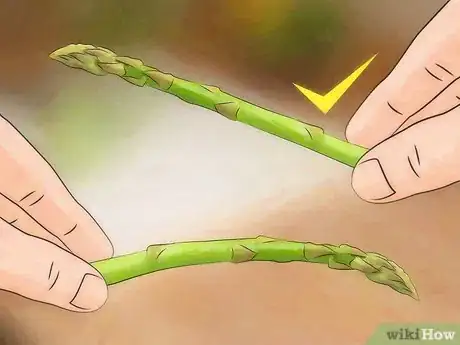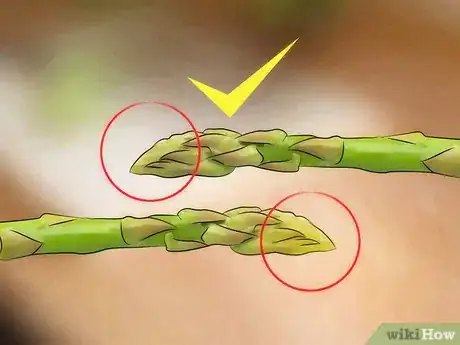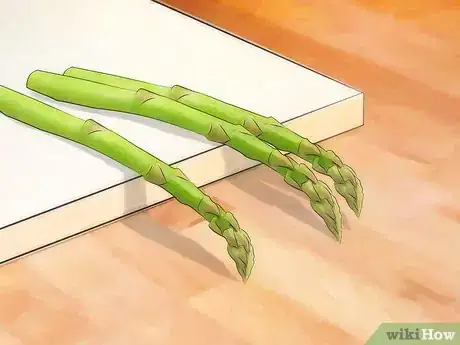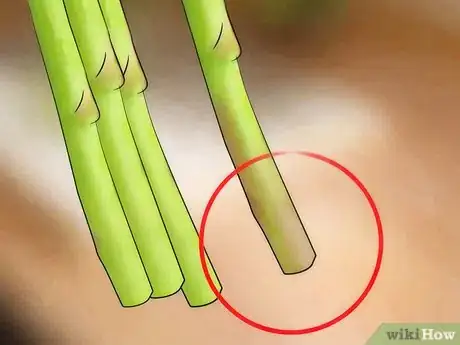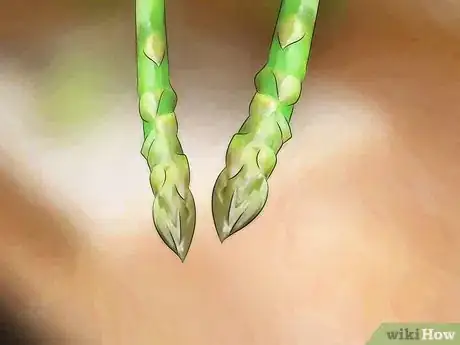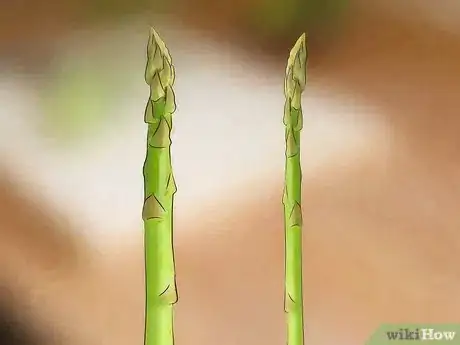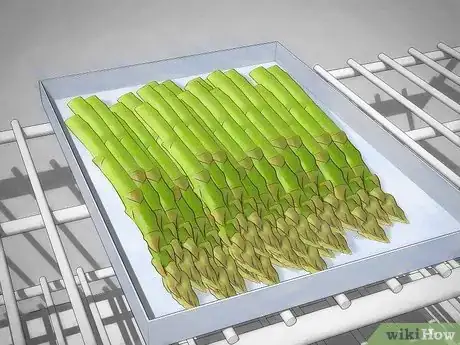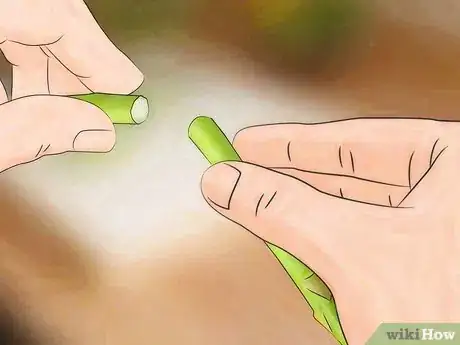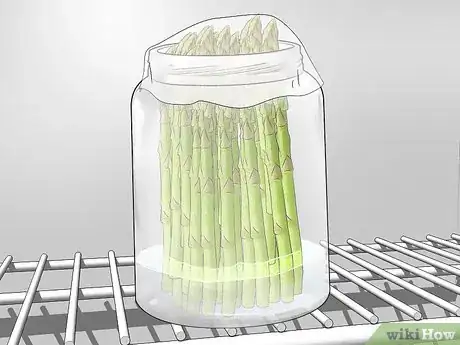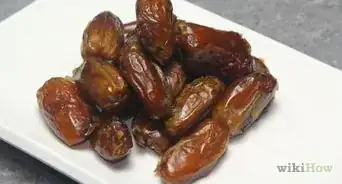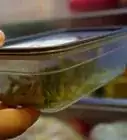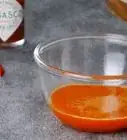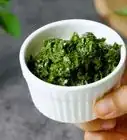This article was co-authored by wikiHow Staff. Our trained team of editors and researchers validate articles for accuracy and comprehensiveness. wikiHow's Content Management Team carefully monitors the work from our editorial staff to ensure that each article is backed by trusted research and meets our high quality standards.
wikiHow marks an article as reader-approved once it receives enough positive feedback. In this case, 93% of readers who voted found the article helpful, earning it our reader-approved status.
This article has been viewed 127,023 times.
Learn more...
Asparagus is a popular vegetable that can be included in a variety of delicious dishes. These stalky veggies are especially popular during the springtime when they are in season. Choosing quality asparagus can be a little tricky, but it is worth it to learn a few tips so you can make sure you get the best tasting asparagus possible.
Steps
Determining the Freshness of Asparagus
-
1Look for asparagus spears that are firm to the touch. They should be straight and not bendable; if you try bending the spear, it should be brittle and "crack." Stalks should be firm but tender.
-
2Check the tips of the asparagus spears. For the main part, they should be closed tightly. A nice dark green or purple tinge on the tips is a good indication of quality. If the tips are yellowish or dried out, the asparagus is too old.[1]Advertisement
-
3Avoid blemished, mottled, or wilting asparagus. If you do find asparagus like this on special and you're prepared to make soup, then grab a bargain. Asparagus with flowers is long past its prime, so avoid that at all costs.[2]
-
4Look at the ends of the asparagus stalks. Your asparagus stalks should be moist and plump. If the stalks look dry, cracked, or “woody” they are probably older and you should find some that are fresher.[3]
Choosing Asparagus Based on Type
-
1Choose the diameter of the spears according to your needs. The size does not affect the tenderness of the spears; rather, you should be looking for signs of freshness instead. Sometimes smaller asparagus is simply a better look for your food presentation but you will get more food from the larger stalks, especially if the price is per bunch.
-
2Pick the color of asparagus you want. There are three different types of asparagus when you distinguish based on color. They vary in constitution as well as color. The three colors of asparagus are:
- Green – Green asparagus gets its color from the process of photosynthesis as the stalk comes out of the ground into the sunlight. This type of asparagus should be a bright green color with purple patches.
- White – White asparagus is the same as green asparagus except that it is grown in the dark, so there is no color development from photosynthesis. Because it is grown more artificially (without access to direct sunlight), this type of asparagus is usually more expensive.
- Purple – Purple asparagus is a different variety altogether. It derives its color from high levels of antioxidants in the stalks and has a lower fiber content than the green or white variety. This distinction makes purple asparagus tenderer and sweeter tasting.
-
3Choose the best type for the flavor you want. Thinner asparagus stems are typically more tender and sweeter. Bigger, fatter asparagus spears are usually meatier in texture and have a stronger asparagus flavor.[4]
Storing Asparagus
-
1Put your asparagus in the refrigerator. Unlike some dry vegetables, asparagus needs to be stored in the refrigerator. Asparagus left out on the counter or in the pantry will go bad very quickly. For best results, keep your asparagus in the refrigerator so it will last longer.[5]
- Try putting the asparagus in a plastic bag before you put it in the refrigerator.
-
2Keep the stalk ends trimmed and damp. To help your asparagus stay fresh, trim the ends of the stalk before you put it in the fridge. Wrap a damp paper towel around the ends to keep the asparagus damp and help it retain its moisture.[6]
-
3Make your asparagus last longer. To help your asparagus last longer, especially if you won’t be using it for several days (up to a week) after purchasing it, cut off one inch of the stalks at the bottom and put the asparagus upright in a cup filled with a little bit of water (probably about one inch standing water).[7]
- Put a plastic bag over the top of the asparagus and put it in the refrigerator.
- If the water starts to get cloudy, pour it out and replace it with fresh water.
- This will help your asparagus last many days longer.
Community Q&A
-
QuestionIf green asparagus is white on the ends, is it still good?
 MicheleTop AnswererThe blunt end of the asparagus may sometimes be white, especially in young plants. There are also varieties of white and purple asparagus
MicheleTop AnswererThe blunt end of the asparagus may sometimes be white, especially in young plants. There are also varieties of white and purple asparagus -
QuestionCan I use asparagus with black tips?
 MicheleTop AnswererBlack tips could be an indication of spoilage. If the tips are also very soft, then throw them away.
MicheleTop AnswererBlack tips could be an indication of spoilage. If the tips are also very soft, then throw them away. -
QuestionThe tips of the asparagus are slimy as they come out of the package.
 IsoldeTop AnswererIt the asparagus is slimy, it is past being good and needs to be composted. You may still be able to salvage the stems for soup or stew though, depending how much the sliminess has traveled downward.
IsoldeTop AnswererIt the asparagus is slimy, it is past being good and needs to be composted. You may still be able to salvage the stems for soup or stew though, depending how much the sliminess has traveled downward.
References
- ↑ http://www.realsimple.com/food-recipes/shopping-storing/food/fresh-pick-asparagus
- ↑ http://www.eatbydate.com/vegetables/fresh-vegetables/asparagus/
- ↑ https://www.thekitchn.com/fresh-and-tasty-how-to-buy-cle-112033
- ↑ https://www.thekitchn.com/fresh-and-tasty-how-to-buy-cle-112033
- ↑ http://www.cookinglight.com/food/in-season/in-season-asparagus
- ↑ http://www.realsimple.com/food-recipes/shopping-storing/food/fresh-pick-asparagus
- ↑ https://www.youtube.com/watch?v=DvZCSvFuqd0
About This Article
To choose asparagus, look for spears that are firm and not bendable. Also, choose spears that have a dark green or purple tint on the tips since that's a sign that they're fresh. Avoid asparagus that looks yellowish or dried out, which is likely old. You should also avoid getting asparagus that's wilted or blemished, and instead opt for asparagus that's moist, plump, and crisp. For tips on how to choose between different varieties of asparagus, scroll down!
